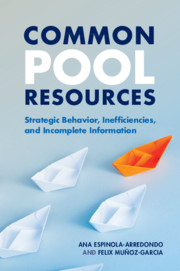Book contents
- Frontmatter
- Contents
- List of Figures
- List of Matrices
- Preface
- 1 Introduction
- 2 Common Pool Resources in a Static Setting
- 3 Common Pool Resources in a Dynamic Setting
- 4 Entry Deterrence in the Commons
- 5 Repeated Interaction in the Commons
- 6 Commons under Incomplete Information
- 7 Signaling in the Commons
- Appendix A Game Theory Tools
- Appendix B Solutions to Selected End-of-Chapter Exercises
- Bibliography
- Index
1 - Introduction
Published online by Cambridge University Press: 03 August 2023
- Frontmatter
- Contents
- List of Figures
- List of Matrices
- Preface
- 1 Introduction
- 2 Common Pool Resources in a Static Setting
- 3 Common Pool Resources in a Dynamic Setting
- 4 Entry Deterrence in the Commons
- 5 Repeated Interaction in the Commons
- 6 Commons under Incomplete Information
- 7 Signaling in the Commons
- Appendix A Game Theory Tools
- Appendix B Solutions to Selected End-of-Chapter Exercises
- Bibliography
- Index
Summary
WHAT ARE COMMON POOL RESOURCES?
If we ask you to find examples of common pool resources (CPRs), you may consider fishing grounds, hunting grounds, or forests, along with oil fields, pastures, irrigation systems, and aquifers. Other, more recent, examples may include the use of a computer facility or Wi-Fi internet connections that require no password. But, what are the distinctive features that these examples, andCPRs in general, exhibit? For us to qualify a good or service as a CPR, it needs to satisfy two properties:
1. It must exhibit rivalry(rival goods), that is, its consumption by one individual reduces the amount of the good available to other individuals. This property holds in all the above examples, where a larger fishing catch by one fisherman reduces the available stock that other fisherman can catch; or the internet browsing by one more individual reduces the Wi-Fi speed other individuals can enjoy.
2. It must be nonexcludable , which means that preventing an individual from enjoying the good is costly or impossible. Again, the above examples satisfy this property, since preventing a new fisherman from accessing a fishing ground is relatively costly.
DIFFERENCES BETWEEN CPRS AND OTHER GOODS
How do CPRs differ from the other types of goods and services we encounter every day? Table 1.1 classifies different types of goods according to whether they satisfy the above two properties: the rows consider whether the good is rival, while the columns evaluate whether the good is excludable. As suggested above, CPRs are rival in consumption but nonexcludable, leaving us with three other types of goods to discuss:
a. Private goods: Starting from private goods, such as an apple, we see that its consumption is rival (if you eat it, I cannot enjoy the same apple) and excludable (if you don't pay for an apple, you cannot eat it).
b. Club goods: We can then move on to club goods, such as a gym membership. Club goods are nonrival since the good can be enjoyed by several members without affecting each other's utility, unless the gym becomes congested. In addition, they are excludable since gym owners can easily prevent nonmembers from accessing the center by requiring users to show a membership card.
Information
- Type
- Chapter
- Information
- Common Pool ResourcesStrategic Behavior, Inefficiencies, and Incomplete Information, pp. 1 - 6Publisher: Cambridge University PressPrint publication year: 2021
